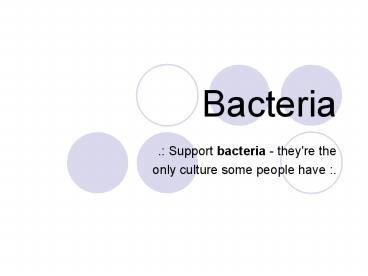Bacteria - PowerPoint PPT Presentation
Title:
Bacteria
Description:
Bacteria.: Support bacteria - they're the only culture some people have :. What is bacteria? True bacteria are the oldest organisms on earth organisms made up of just ... – PowerPoint PPT presentation
Number of Views:82
Avg rating:3.0/5.0
Title: Bacteria
1
Bacteria
- . Support bacteria - they're theonly culture
some people have .
2
What is bacteria?
- True bacteria are the oldest organisms on earth
- organisms made up of just one cell
- capable of multiplying by themselves, as they
have the power to divide - some bacteria can cause diseases
- Sometimes they are just in the wrong place but
other times they are designed to invade our
bodies!! - Bacterial infections are usually treated with a
special antibiotic that only kills the bacterium
that has caused the disease.
3
Common Shapes of Bacteria
BACILLUS
COCCUS
SPIRILLUM
4
Reproduction of Bacteria
- Bacteria may reproduce either asexually or
sexually. - Primarily they reproduce asexually, which they
accomplish by simple cell division. - During this process, one cell divides into two
daughter cells with the development of a
transverse cell wall. - genetic variations can occur within individual
cells through recombinant
5
Malicious Bacteria (
- Why did the paramecium cross the road?
- He was stuck to the chicken's butt.
6
Typhoid Fever and Paratyphoid Fever
- is an infectious feverish disease
- severe symptoms in the digestive system
- caused by an infection with the bacterium
Salmonella typhi, - which is only found in humans and may lead to
serious illness. - Salmonella typhi can only attack humans
- the bacterium is passed on with water and foods
and can withstand both drying and refrigeration.
7
Salmonella and Food Poisoning
- found in poultry, eggs, unprocessed milk and in
meat and water - attacks the stomach and intestines
- enters the lymph tracts, which carry water and
protein to the blood, and the blood itself - Symptoms-
- Diarrhea (constipation), headaches, stomach
cramps, nausea and vomiting
8
Anthrax
- a bacterial disease caused by an organism called
Bacillus anthracis - is capable of producing spores
- Its a disease of grass-eating animals such as
sheep, goats, cattle and horses so humans wont
get infected unless they are exposed to infected
animals - Symptoms -
- Vomiting, nausea, fever
IT IS NOT CONTAGIOUS!
9
Botulism
- serious paralytic illness caused by a nerve toxin
- produced by the bacterium Clostridium botulinum
(found in soil) - cant be detected unless diagnosed (ex a cat
scan) - 110 cases of botulism each year
- Clostridium botulinum
- name of a group of bacteria
- rod-shaped organisms grow best in low oxygen
conditions. - bacteria form spores - allows them to survive in
a dormant state
10
Types of Botulism
- Foodborne botulism caused by eating foods that
contain the botulism toxin (25 of the cases) - Wound botulism is caused by toxin produced from a
wound infected with Clostridium botulinum (72 of
the cases) - Infant botulism is caused by consuming the spores
of the botulinum bacteria, which then grow in the
intestines and release toxin - NOTE ALL TYPES ARE FATAL AND SHOULD
RECEIVE MEDICAL ATTENTION!!
11
The Plague
- The Black Death wiped out complete villages in
Europe in the 14th century. Largest outbreak of a
bacteria. - The epidemic lasted about 200 years and affected
all aspects of social and economic life. - Carried by fleas, rodents and humans.
12
Gram Positive ()
- Gram positive bacteria have simple walls composed
primarily of peptidoglycan - Secrete exotoxins which can infect a host without
the bacteria actually being present
13
Gram Negative (-)
- Gram negative bacteria have relatively complex
walls with lipopolysaccharides which are often
toxic, making the walls of gram-negative bacteria
toxic - Often more resistant than gram positive Bacteria
to antibiotics - Usually more deadly than gram-positive bacteria,
but must be present for symptoms to occur. Do
not secrete exotoxins
14
Beneficial Bacteria )
- Why did the bacteria cross the road?
- To prove he wasn't chicken.
15
Good Bacteria
- Used in soil enrichment
- Used for pickling and preserving
- Used for fermentation
- Used to decompose organic waste
- The bacteria that live within us, help to build
and maintain a strong gastrointestinal barrier
against invasion and damage by pathogenic
bacteria, viruses, protozoa and toxic substances.
Lactobacillus reuteri
16
Bacteria is a part of everyday life
- The bacteria that live within us as symbionts,
help to build and maintain a strong
gastrointestinal barrier against invasion and
damage by pathogenic bacteria, viruses, protozoa
and toxic substances.
17
Combating Bad Bacteria D
- Why did the bacteria cross the playground?
- To get to the other slide..
18
Antibodies
- An antibody is a protein complex used by the
immune system to identify and neutralize bacteria
- Each antibody recognizes a specific antigen
unique to its target - Antibodies that recognize bacteria mark them for
ingestion by macrophages. - Together with the plasma component complement,
antibodies can kill bacteria directly.
19
Antibiotics
- Drugs that help cure certain infections by
impairing bacteria. - First antibiotic discovered was penicillin.
- Some fungi produce antibiotics used to treat
bacterial infections - The dark side is that antibiotics caused the
evolution of antibiotic-resistant populations of
the very bacteria the drugs were meant to kill
20
Prevention
- Improvements in prevention of bacterial
infections come more from improved public health
policies than so-called wonder-drugs.
Generally little can be done to combat bacterial
infections directly other than keeping your
living conditions and yourself sanitary.































